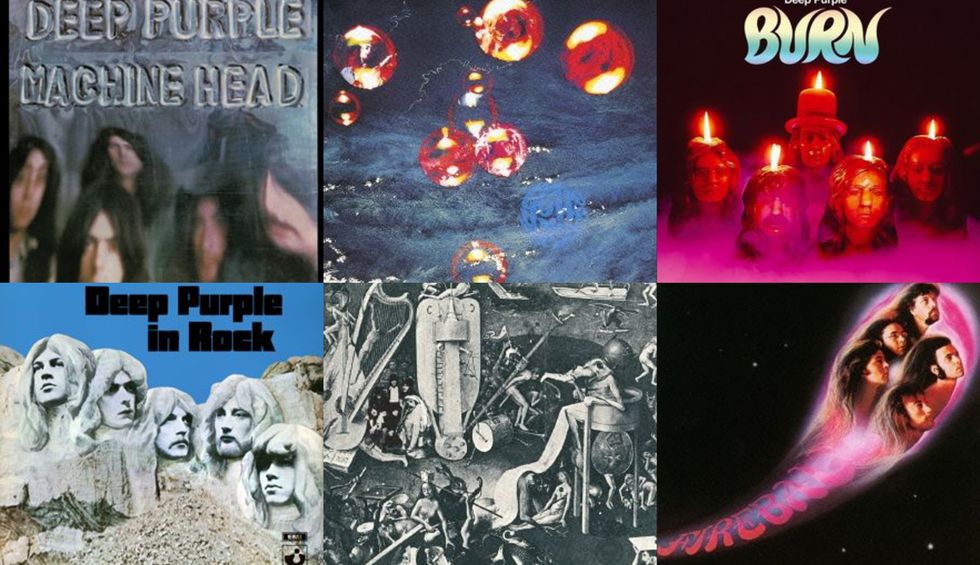Theory: Intermediate
Lesson Overview:
• Learn how to invert power chords.
• Understand how to create fiery “repeater” licks.
• Develop a deeper knowledge of arpeggios. Click here to download a printable PDF of this lesson's notation.
It’s accepted that Deep Purple is one of the most important and influential rock bands ever. “Smoke on the Water” is arguably the best-known guitar riff of all time—as many guitar store employees can attest—and Ritchie Blackmore was a prime influence on all the shredders that came up in the ’80s. Considered heavy metal pioneers, the band produced many genre classics and, due to Jon Lord’s sophisticated organ playing, helped pave the way for incorporating classical music elements in hard rock. In this lesson, we’ll take a look at some of the rhythm and lead concepts Blackmore used during his time in Deep Purple.
Blackmore’s memorable riffs sounded unique and fresh, even though many of them were based around the same minor pentatonic boxes we all know and love. The rhythm examples in this lesson feature ideas you can apply to other chord progressions or keys to create your own, personalized variations.
The same goes for Blackmore’s solos. Every solo he played on Deep Purple records had distinct melodic ideas. The fast lines he used to link his melodic statements are all based on a few patterns that I’ll break down for you. Soon you’ll be ripping on your own Blackmore-inspired licks and solos.
In the early ’70s, Blackmore switched from his Gibson ES-335 to a Stratocaster plugged into a wall of Marshall amps. After this switch he made heavy use of the Strat’s trem to give sustained notes a wide and wild-sounding vibrato. This became a big part of his style.
Ex.1 shows Blackmore’s use of dyads. He’d commonly invert a power chord and put the root on top with the 5 on the bottom. It’s exactly the sound used in “Smoke on the Water” and “Space Truckin’.” Occasionally, Blackmore would throw in a dyad based on the b5 for a bluesy feel.
Click here for Ex. 1
Most of Blackmore’s riffs are based around single notes, like Ex. 2, which is also played with a shuffle feel. It uses the same pentatonic boxes as the previous example, along with rests to add more groove.
Click here for Ex. 2
Ex. 3 uses arpeggiated power chords, similar to what Blackmore does on the verses of “Smoke on the Water” or the chorus of “Black Night.” In this example, I use the formula from the “Child in Time” chord progression, which is technically a bVII–Im–VI–bVII progression, but works beautifully with power chords. These arpeggios can be used as the main rhythmic pattern for a chord progression, as in this example, or as a turnaround at the end of a chorus leading back to the start of a riff.
Click here for Ex. 3
Let’s switch gears towards lead playing. First, we’ll check out a few small repeating patterns Blackmore used to construct his speedy blues-rock lines. These can be found in most of Blackmore’s solos. Ex. 4 is a simple G minor pentatonic (G–Bb–C–D–F) lick on the 1st and 2nd strings. Use your index finger to barre the notes that are on the same fret. It’s a rhythmically displaced three-note lick that switches up the accents over a series of 16th-notes. There’s almost a triplet feel to it. The cool thing about these little repeating licks is that you can loop them and speed them up to create some bluesy shred licks.
Click here for Ex. 4
Ex. 5 is another three-note repeating pattern played in a binary rhythm. We’re in G minor pentatonic again, but this time on the 3rd and 4th strings. It’s basically a reversed version of the previous lick.
Click here for Ex. 5
Ex. 6 stays in the pentatonic box, but this time we move to A minor pentatonic (A–C–D–E–G) and add the b5 (Eb) and 6 (F#). The latter gives the lick a more Dorian-flavored sound.
Click here for Ex. 6
In the next two examples, we’ll explore ways to combine these fragments into licks. This will help you generate your own ideas.
Ex. 7 starts off with a typical blues-rock lick that’s followed by some staccato bends before it moves into the lines from Ex. 6 and Ex. 5. The lick is in B minor and ends on the b3—one of Blackmore’s favorite target notes.
Click here for Ex. 7
Ex. 8 begins with the same short phrase, then draws from Ex. 4, Ex. 6, and Ex. 5, and finally adds the b5 for a bluesy sound before ending on the root (F#).
Click here for Ex. 8
Experiment with different combinations of the previous examples and pay attention to the melodic and technical flow a new combination might offer. Play your creations with hammer-ons and pull-offs, alternate picking, or whatever techniques inspire you. When you find something you like, be sure to move it to other keys. Explore!



















